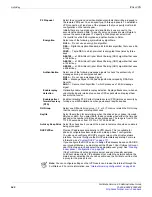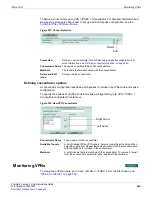
SSL VPN
ssl.root
FortiGate Version 4.0 Administration Guide
01-400-89802-20090424
551
•
SSL VPN
An SSL VPN (Secure Sockets Layer virtual private network) is a form of VPN that can be
used with a standard Web browser. SSL VPN does not require the installation of
specialized client software on end users’ computers, and is ideal for applications including
web-based email, business and government directories, file sharing, remote backup,
remote system management, and consumer-level electronic commerce.
The two modes of SSL VPN operation (supported in NAT/Route mode only) are:
•
web-only mode, for thin remote clients equipped with a web-browser only.
•
tunnel mode, for remote computers that run a variety of client and server applications.
When the FortiGate unit provides services in web-only mode, a secure connection
between the remote client and the FortiGate unit is established through the SSL VPN
security in the FortiGate unit and the SSL security in the web browser. After the
connection has been established, the FortiGate unit provides access to selected services
and network resources through a web portal. The FortiGate SSL VPN web portal has a
widget-based layout with customizable themes. Each widget is displayed in a 1- or 2-
column format with the ability to modify settings, minimize the widget window, or other
functions depending on the type of content within the widget.
When users have complete administrative rights over their computers and use a variety of
applications, tunnel mode allows remote clients to access the local internal network as if
they were connected to the network directly.
This section provides information about the features of SSL VPN available for
configuration in the web-based manager. Only FortiGate units that run in NAT/Route mode
support the SSL VPN feature.
If you enable virtual domains (VDOMs) on the FortiGate unit, VPN SSL is configured
separately for each virtual domain. For details, see
“Using virtual domains” on page 103
This section describes:
•
•
•
•
ssl.root
The FortiGate unit has a virtual SSL VPN interface called ssl.<vdomname>. The root
VDOM, called ssl.root, appears in the firewall policy interface lists and static route
interface lists. You can use the ssl-root interface to allow access to additional networks
and facilitate a connected user’s ability to browse the Internet through the FortiGate unit.
SSL VPN tunnel-mode access requires the following firewall policies:
•
External > Internal, with the action set to SSL, with an SSL user group
Note:
For detailed instructions about how to configure web-only mode or tunnel-mode
operation, see the
Summary of Contents for Gate 60D
Page 705: ...www fortinet com...
Page 706: ...www fortinet com...

































